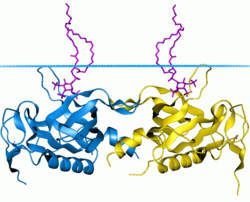플렉스트린 호몰로지 도메인
Pleckstrin homology domain Tyrosine-단백질 키나아제 BTK의 PH 영역 | |||||||||
| 식별자 | |||||||||
|---|---|---|---|---|---|---|---|---|---|
| 기호 | PH | ||||||||
| Pfam | PF00169 | ||||||||
| Pfam 씨 | CL0266 | ||||||||
| 인터프로 | IPR001849 | ||||||||
| 스마트 | PH | ||||||||
| 프로사이트 | PDOC50003 | ||||||||
| SCOP2 | 1dyn / SCOPe / SUPFAM | ||||||||
| OPM 슈퍼 패밀리 | 49 | ||||||||
| OPM단백질 | 1플스 | ||||||||
| CDD | cd00821 | ||||||||
| |||||||||
플렉스트린 호몰로지 도메인(PHIP) 또는 (PHIP)은 세포내 신호에 관여하는 광범위한 단백질 또는 세포골격의 성분으로 발생하는 약 120개의 아미노산의 단백질 영역이다.[1][2][3][4][5][6][7]
이 영역은 생물 막(예: 인산염(3,4,5)-트리스포스포인산염과 인산염(4,5)-비스포인산염)[8] 내 인산염과 이단성 G 단백질의 [9]βγ-subunit과 단백질 키나제 C를 결합시킬 수 있다.[10]이러한 상호작용을 통해 PH 영역은 단백질을 서로 다른 세포막으로 모집하여 적절한 세포 구획으로 표적화하거나 신호 전달 경로의 다른 구성 요소와 상호작용을 가능하게 하는 역할을 한다.
지질 결합 특이성
Individual PH domains possess specificities for phosphoinositides phosphorylated at different sites within the inositol ring, e.g., some bind phosphatidylinositol (4,5)-bisphosphate but not phosphatidylinositol (3,4,5)-trisphosphate or phosphatidylinositol (3,4)-bisphosphate, while others may possess the requisite affinity.이는 인산염 3-키나아제나 PTEN과 같은 이노시톨 링 위에서 이들 부위의 인산염이나 탈인산화를 일으키는 효소의 활동에 민감한 단백질을 포함하는 서로 다른 PH영역을 모집하게 하기 때문에 중요하다.따라서 그러한 효소는 인광체 제품을 결합할 수 있는 PH 도메인을 보유한 다운스트림 신호 단백질의 국산화 방법을 변조하여 세포 기능에 미치는 영향의 일부를 발휘한다.
구조
여러 PH 도메인의 3D 구조가 결정되었다.[11]알려진 모든 케이스는 두 개의 수직 반병렬 베타 시트로 구성된 공통 구조를 가지고 있고, 그 다음에 C-단자 암페타 나선이 있다.베타 가닥을 연결하는 루프는 길이가 크게 달라 PH 도메인은 도메인의 특수성의 근원을 제공하면서 상대적으로 탐지가 어렵다.PH 영역 중 유일하게 보존된 잔류물은 영역의 핵심을 핵화하는 역할을 하는 알파 나선 내에 위치한 단일 트립토판이다.
PH영역을 포함한 단백질
PH 도메인은 OSBP나 ARF와 같은 많은 다른 단백질에서 발견될 수 있다.이 경우 골지 기구에 대한 모집은 PtdIns와 ARF 모두에 따라 결정된다.많은 수의 PH 도메인은 인산염에 대한 친화력이 떨어지고 단백질 결합 도메인으로 기능하도록 가정된다.사카로마이오스 세레비시아에 있는 게놈 전체에서 33개의 효모 PH 도메인의 대부분이 실제로 인산염에 결합되어 문란하다는 것을 보여주었고, 단 하나의 (Num1-PH)만이 매우 구체적인 행동을 했다.[12] PH 도메인을 포함하는 단백질은 다음 계열에 속한다.
- 이 영역이 처음 검출된 단백질인 플렉스트린은 혈소판 내 단백질 키나아제 C의 주요 기질이다.플렉스트린은 두 개의 PH 도메인을 포함한다.ARAP 단백질은 5개의 PH영역을 포함한다.
- Akt/Rac 계열, 단백질 키나제 D1 및 트라이파노소말 NrkA 계열과 같은 세린/트레오닌 고유의 단백질 키나제.
- Btk/Itk/Tec 하위 패밀리에 속하는 비수용체 타이로신 키나제.
- 인슐린 수용체 기질 1(IRS-1)
- 작은 G단백질 조절기: dbl 유사 계열의 64 RoGEF와 [13]ABR, BCR 또는 ARAP 단백질과 같은 단백질을 활성화하는 여러 GTPase.
- 다이나민(InterPro:IPR001401 참조), 선충병(Caenorhabditis) 키네신 유사 단백질 언-104(InterPro: IPR001752 참조), 스펙터린 베타체인, 싱트로핀(2 PH 도메인), S. 세레비시아 핵이동 단백질 NUM1을 참조한다.
- 옥시스테롤 결합 단백질 OSBP, S. 세레비시아 OSH1, YHR073w.
- 세라마이드 키나아제는 세라마이드-1-인산염에 인산염으로 세라마이드에 세라마이드를 번식시키는 지질 키나아제다.[14]
- GRK2 하위 제품군의 GRK(단백질 수용체 키나제) 단백질 수용체 키나제(베타-아드레날린 수용체 키나제):GRK2와 GRK3.[15]
하위 가족
예
이 영역을 포함하는 단백질을 인코딩하는 인간의 유전자는 다음과 같다.
- ABR, ADRBK1, ADRBK2, AFAP, AFAP1, AFAP1L1, AFAP1L2, AKAP13, AKT1, AKT2, AKT3, ANLN, APB1IP, APPL1, APPL2, ARHGAP10, ARHGAP12, ARHGAP15, ARHGAP21, ARHGAP22, ARHGAP23, ARHGAP24, ARHGAP25, ARHGAP26, ARHGAP27, ARHGAP9, ARHGEF16, ARHGEF18, ARHGEF19, ARHGEF2, ARHGEF3, ARHGEF4, ARHGEF5, ARHGEF6, ARHGEF7, ARHGEF9, ASEF2,
- BMX, BTK,
- C20orf42, C9orf100, CADPS, CADPS2, CDC42BPA, CDC42BPB, CDC42BPG, CENTA1, CENTA2, CENTB1, CENTB2, CENTB5, CENTD1, CENTD2, CENTD3, CENTG1, CENTG2, CENTG3, CERK, CIT, CNKSR1, CNKSR2, COL4A3BP, CTGLF1, CTGLF2, CTGLF3, * CTGLF4, CTGLF5, CTGLF6,
- DAB2IP, DAPP1, DDEF1, DDEF2, DDEFL1, DEF6, DEPDC2, DGKD, DGKH, DGKK, DNM1, DNM2, DNM3, DOCK10, DOCK11, DOCK9, DOK1, DOK2, DOK3, DOK4, DOK5, DOK6, DTGCU2,
- EXOC8,
- FAM109A, FAM109B, FARP1, FARP2, FGD1, FGD2, FGD3, FGD4, FGD5, FGD6,
- GAB1, GAB2, GAB3, GAB4, GRB10, GRB14, GRB7,
- IRS1, IRS2, IRS4, ITK, ITSN1, ITSN2,
- KALRN, KIF1A, KIF1B, KIF1Beta,
- MCF2, MCF2L, MCF2L2, MRIP, MYO10,
- NET1, NGEF,
- OBPH1, OPHN1, OSBP1, OSBP2, OSBPL10, OSBPL11, OSBPL3, OSBPL5, OSBPL6, OSBPL7, OSBPL8, OSBPL9,
- PHLDA2, PHLDA3, PHLDB1, PHLDB2, PHLPP, PIP3-E, PLCD1, PLCD4, PLCG1, PLCG2, PLCH1, PLCH2, PLCL1, PLCL2, PLD1, PLD2, PLEK, PLEK2, PLEKHA1, PLEKHA2, PLEKHA3, PLEKHA4, PLEKHA5, PLEKHA6, PLEKHA7, PLEKHA8, PLEKHB1, PLEKHB2, PLEKHC1, PLEKHF1, PLEKHF2, PLEKHG1, PLEKHG2, PLEKHG3, PLEKHG4, PLEKHG5, PLEKHG6, PLEKHH1, PLEKHH2, PLEKHH3, PLEKHJ1, PLEKHK1, PLEKHM1, PLEKHM2, PLEKHO1, PLEKHQ1, PREX1, PRKCN, PRKD1, PRKD2, PRKD3, PSCD1, PSCD2, PSCD3, PSCD4, PSD, PSD2, PSD3, PSD4, RALGPS1, RALGPS2, RAPH1,
- RASA1, RASA2, RASA3, RASA4, RASAL1, RASGRF1, RGNF, ROCK1, RTKN,
- SBF1, SBF2, SCAP2, SGEF, SH2B, SH2B1, SH2B2, SH2B3, SH3BP2, SKAP1, SKAP2, SNTA1, SNTB1, SNTB2, SOS1, SOS2, SPATA13, SPNB4, SPTBN1, SPTBN2, SPTBN4, SPTBN5, STAP1, SWAP70, SYNGAP1,
- TBC1D2, TEC, TIAM1, TRIOBP, TYL,
- URP1, URP2,
- VAV1, VAV2, VAV3, VEPH1
참고 항목
참조
- ^ Mayer BJ, Ren R, Clark KL, Baltimore D (May 1993). "A putative modular domain present in diverse signaling proteins". Cell. 73 (4): 629–30. doi:10.1016/0092-8674(93)90244-K. PMID 8500161. S2CID 44282241.
- ^ Haslam RJ, Koide HB, Hemmings BA (May 1993). "Pleckstrin domain homology". Nature. 363 (6427): 309–10. Bibcode:1993Natur.363..309H. doi:10.1038/363309b0. PMID 8497315. S2CID 4334376.
- ^ Musacchio A, Gibson T, Rice P, Thompson J, Saraste M (September 1993). "The PH domain: a common piece in the structural patchwork of signalling proteins". Trends in Biochemical Sciences. 18 (9): 343–8. doi:10.1016/0968-0004(93)90071-T. PMID 8236453.
- ^ Gibson TJ, Hyvönen M, Musacchio A, Saraste M, Birney E (September 1994). "PH domain: the first anniversary". Trends in Biochemical Sciences. 19 (9): 349–53. doi:10.1016/0968-0004(94)90108-2. PMID 7985225.
- ^ Pawson T (February 1995). "Protein modules and signalling networks". Nature. 373 (6515): 573–80. Bibcode:1995Natur.373..573P. doi:10.1038/373573a0. PMID 7531822. S2CID 4324726.
- ^ Ingley E, Hemmings BA (December 1994). "Pleckstrin homology (PH) domains in signal transduction". Journal of Cellular Biochemistry. 56 (4): 436–43. doi:10.1002/jcb.240560403. PMID 7890802. S2CID 23154429.
- ^ Saraste M, Hyvönen M (June 1995). "Pleckstrin homology domains: a fact file". Current Opinion in Structural Biology. 5 (3): 403–8. doi:10.1016/0959-440X(95)80104-9. PMID 7583640.
- ^ Wang DS, Shaw G (December 1995). "The association of the C-terminal region of beta I sigma II spectrin to brain membranes is mediated by a PH domain, does not require membrane proteins, and coincides with a inositol-1,4,5 triphosphate binding site". Biochemical and Biophysical Research Communications. 217 (2): 608–15. doi:10.1006/bbrc.1995.2818. PMID 7503742.
- ^ Wang DS, Shaw R, Winkelmann JC, Shaw G (August 1994). "Binding of PH domains of beta-adrenergic receptor kinase and beta-spectrin to WD40/beta-transducin repeat containing regions of the beta-subunit of trimeric G-proteins". Biochemical and Biophysical Research Communications. 203 (1): 29–35. doi:10.1006/bbrc.1994.2144. PMID 8074669.
- ^ Yao L, Kawakami Y, Kawakami T (September 1994). "The pleckstrin homology domain of Bruton tyrosine kinase interacts with protein kinase C". Proceedings of the National Academy of Sciences of the United States of America. 91 (19): 9175–9. Bibcode:1994PNAS...91.9175Y. doi:10.1073/pnas.91.19.9175. PMC 44770. PMID 7522330.
- ^ Riddihough G (November 1994). "More meanders and sandwiches". Nature Structural Biology. 1 (11): 755–7. doi:10.1038/nsb1194-755. PMID 7634082. S2CID 5410578.
- ^ Yu JW, Mendrola JM, Audhya A, Singh S, Keleti D, DeWald DB, Murray D, Emr SD, Lemmon MA (March 2004). "Genome-wide analysis of membrane targeting by S. cerevisiae pleckstrin homology domains". Molecular Cell. 13 (5): 677–88. doi:10.1016/S1097-2765(04)00083-8. PMID 15023338.
- ^ Fort P, Blangy A (June 2017). "The Evolutionary Landscape of Dbl-Like RhoGEF Families: Adapting Eukaryotic Cells to Environmental Signals". Genome Biol Evol. 9 (6): 1471–1486. doi:10.1093/gbe/evx100. PMC 5499878. PMID 28541439.
- ^ Sugiura M, Kono K, Liu H, Shimizugawa T, Minekura H, Spiegel S, Kohama T (June 2002). "Ceramide kinase, a novel lipid kinase. Molecular cloning and functional characterization". The Journal of Biological Chemistry. 277 (26): 23294–300. doi:10.1074/jbc.M201535200. PMID 11956206.
- ^ Komolov KE, Benovic JL (January 2018). "G protein-coupled receptor kinases: Past, present and future". Cellular Signalling. 41: 17–24. doi:10.1016/j.cellsig.2017.07.004. PMC 5722692. PMID 28711719.
외부 링크
- Nash Lab 단백질 상호작용 도메인 - PH 도메인 설명[영구적 데드링크]
- IMT-2000 3GPP-막군 내 단백질 UMICH 방향-51 - 막군 내 PH 영역의 계산된 방향


